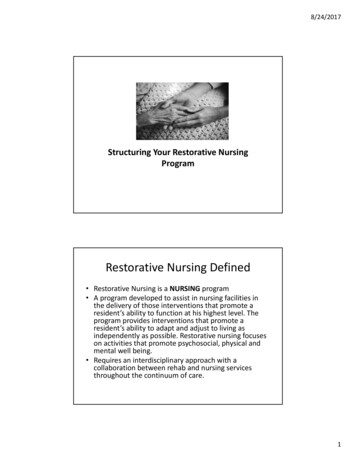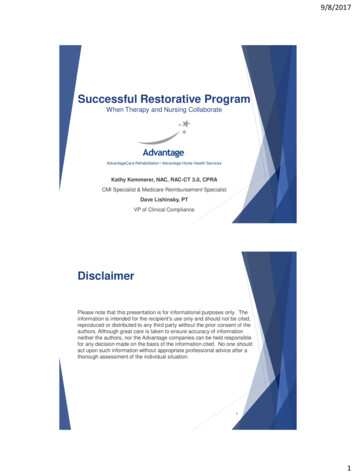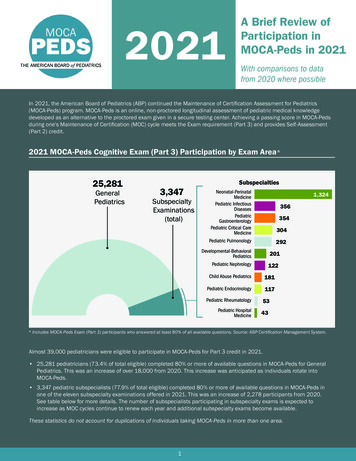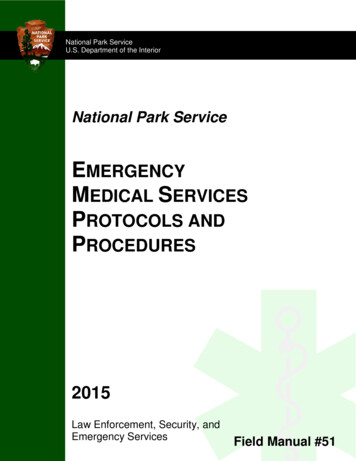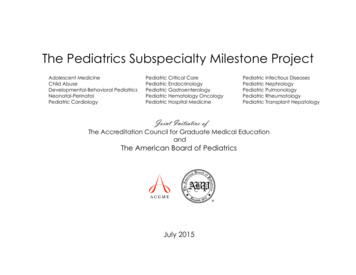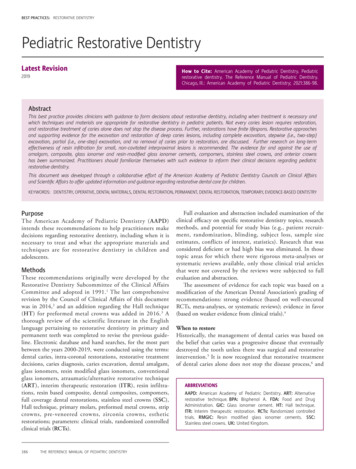
Transcription
BEST PRACTICES: RESTORATIVE DENTISTRYPediatric Restorative DentistryLatest Revision2019How to Cite: American Academy of Pediatric Dentistry. Pediatricrestorative dentistry. The Reference Manual of Pediatric Dentistry.Chicago, Ill.: American Academy of Pediatric Dentistry; 2021:386-98.AbstractThis best practice provides clinicians with guidance to form decisions about restorative dentistry, including when treatment is necessary andwhich techniques and materials are appropriate for restorative dentistry in pediatric patients. Not every caries lesion requires restoration,and restorative treatment of caries alone does not stop the disease process. Further, restorations have finite lifespans. Restorative approachesand supporting evidence for the excavation and restoration of deep caries lesions, including complete excavation, stepwise (i.e., two-step)excavation, partial (i.e., one-step) excavation, and no removal of caries prior to restoration, are discussed. Further research on long-termeffectiveness of resin infiltration for small, non-cavitated interproximal lesions is recommended. The evidence for and against the use ofamalgam, composite, glass ionomer and resin-modified glass ionomer cements, compomers, stainless steel crowns, and anterior crownshas been summarized. Practitioners should familiarize themselves with such evidence to inform their clinical decisions regarding pediatricrestorative dentistry.This document was developed through a collaborative effort of the American Academy of Pediatric Dentistry Councils on Clinical Affairsand Scientific Affairs to offer updated information and guidance regarding restorative dental care for children.KEYWORDS: DENTISTRY, OPERATIVE, DENTAL MATERIALS, DENTAL RESTORATION, PERMANENT, DENTAL RESTORATION, TEMPORARY, EVIDENCE-BASED DENTISTRYPurposeThe American Academy of Pediatric Dentistry (AAPD)intends these recommendations to help practitioners makedecisions regarding restorative dentistry, including when it isnecessary to treat and what the appropriate materials andtechniques are for restorative dentistry in children andadolescents.MethodsThese recommendations originally were developed by theRestorative Dentistry Subcommittee of the Clinical AffairsCommittee and adopted in 1991. 1 The last comprehensiverevision by the Council of Clinical Affairs of this documentwas in 2014,2 and an addition regarding the Hall technique(HT) for preformed metal crowns was added in 2016. 3 Athorough review of the scientific literature in the Englishlanguage pertaining to restorative dentistry in primary andpermanent teeth was completed to revise the previous guideline. Electronic database and hand searches, for the most partbetween the years 2000-2019, were conducted using the terms:dental caries, intra-coronal restorations, restorative treatmentdecisions, caries diagnosis, caries excavation, dental amalgam,glass ionomers, resin modified glass ionomers, conventionalglass ionomers, atraumatic/alternative restorative technique(ART), interim therapeutic restoration (ITR), resin infiltrations, resin based composite, dental composites, compomers,full coverage dental restorations, stainless steel crowns (SSC),Hall technique, primary molars, preformed metal crowns, stripcrowns, pre-veneered crowns, zirconia crowns, estheticrestorations; parameters: clinical trials, randomized controlledclinical trials (RCTs).386THE REFERENCE MANUAL OF PEDIATRIC DENTISTRYFull evaluation and abstraction included examination of theclinical efficacy on specific restorative dentistry topics, researchmethods, and potential for study bias (e.g., patient recruitment, randomization, blinding, subject loss, sample sizeestimates, conflicts of interest, statistics). Research that wasconsidered deficient or had high bias was eliminated. In thosetopic areas for which there were rigorous meta-analyses orsystematic reviews available, only those clinical trial articlesthat were not covered by the reviews were subjected to fullevaluation and abstraction.The assessment of evidence for each topic was based on amodification of the American Dental Association’s grading ofrecommendations: strong evidence (based on well-executedRCTs, meta-analyses, or systematic reviews); evidence in favor(based on weaker evidence from clinical trials).4When to restoreHistorically, the management of dental caries was based onthe belief that caries was a progressive disease that eventuallydestroyed the tooth unless there was surgical and restorativeintervention.5 It is now recognized that restorative treatmentof dental caries alone does not stop the disease process,6 andABBREVIATIONSAAPD: American Academy of Pediatric Dentistry. ART: Alternativerestorative technique. BPA: Bisphenol A. FDA: Food and DrugAdministration. GIC: Glass ionomer cement. HT: Hall technique.ITR: Interim therapeutic restoration. RCTs: Randomized controlledtrials. RMGIC: Resin modified glass ionomer cements. SSC:Stainless steel crowns. UK: United Kingdom.
BEST PRACTICES: RESTORATIVE DENTISTRYrestorations have a finite lifespan. Conversely, some carieslesions may not progress and, therefore, may not need restoration. Contemporary management of dental caries includesidentification of an individual’s risk for caries progression,understanding of the disease process for that individual, andactive surveillance to assess disease progression and managewith appropriate preventive services, supplemented by restorative therapy when indicated.7,8With the exception of reports of dental examiners in clinical trials, studies of reliability and reproducibility of detectingdental caries are not conclusive. 9 There also is minimalinformation regarding validity of caries diagnosis in primaryteeth,5 as primary teeth may require different criteria due tothinner enamel and dentin and broader proximal contacts.10Furthermore, indications for restorative therapy only havebeen examined superficially because such decisions generallyhave been regarded as a function of clinical judgment.11 Decisions for when to restore caries lesions should include at leastclinical criteria of visual detection of enamel cavitations, visualidentification of shadowing of the enamel, and/or radiographicrecognition of enlargement of lesions over time.7,12,13The benefits of restorative therapy include: removing cavitations or defects to eliminate areas that are susceptible to caries;stopping the progression of tooth demineralization; restoringthe integrity of tooth structure; preventing the spread ofinfection into the dental pulp; and preventing the shifting ofteeth due to loss of tooth structure. The risks of restorativetherapy include reducing the longevity of teeth by makingthem more susceptible to fracture, recurrent lesions, restorationfailure, pulp exposure during caries excavation, future pulpalcomplications, and iatrogenic damage to adjacent teeth.14,15Primary teeth may be more susceptible to restoration failuresthan permanent teeth.16 Additionally, before restoration ofprimary teeth, one needs to consider the length of time remaining prior to tooth exfoliation.Recommendations:1. Management of dental caries includes identification ofan individual’s risk for caries progression, understandingof the disease process for that individual, and activesurveillance to assess disease progression and managewith appropriate preventive services, supplemented byrestorative therapy when indicated.2. Decisions for when to restore carious lesions shouldinclude at least clinical criteria of visual detection ofenamel cavitation, visual identification of shadowing ofthe enamel,and/or radiographic recognition of progression of lesions.Deep caries excavation and restorationAmong the objectives of restorative treatment are to repair orlimit the damage from caries, protect and preserve the toothstructure, and maintain pulp vitality whenever possible. TheAAPD's Use of Vital Pulp Therapies in Primary Teeth withDeep Caries Lesions 17 and Pulp Therapy for Primary andImmature Permanent Teeth18 state the treatment objective for atooth affected by caries is to maintain pulpal vitality, especiallyin immature permanent teeth for continued apexogenesis.19With regard to the treatment of deep caries, three methodsof caries removal have been compared to complete excavation,where all carious dentin is removed. Stepwise excavation is atwo-step caries removal process in which carious dentin ispartially removed at the first appointment, leaving caries overthe pulp, with placement of a temporary filling. At the secondappointment, all remaining carious dentin is removed and afinal restoration placed.19 Partial, or one-step, caries excavationremoves part of the carious dentin, but leaves caries over thepulp, and subsequently places a base and final restoration.20,21No removal of caries before restoration of primary molars inchildren aged three to 10 years also has been reported.22Evidence from RCTs and a systematic review shows thatpulp exposures in primary and permanent teeth are significantly reduced using incomplete caries excavation comparedto complete excavation in teeth with a normal pulp or reversible pulpitis. Two trials and a Cochrane review foundthat partial excavation resulted in significantly fewer pulpexposures compared to complete excavation.23-25 Two trialsof step-wise excavation showed that pulp exposure occurredmore frequently from complete excavation compared tostepwise excavation.19,24 There also is evidence of a decrease inpulpal complications and post-operative pain after incompletecaries excavation compared to complete excavation in clinicaltrials, summarized in a meta-analysis.28Additionally, a meta-analysis found the risk for permanentrestoration failure was similar for incompletely and completelyexcavated teeth.28 With regard to the need to reopen a toothwith partial excavation of caries, one RCT that comparedpartial (one-step) to stepwise excavation in permanent molarsfound higher rates of success in maintaining pulp vitalitywith partial excavation, suggesting there is no need to reopenthe cavity and perform a second excavation. 20 Interestingly,two RCTs suggest that restoration without excavation canarrest dental caries so long as a good seal of the final restorationis maintained.22,29Recommendations:1. There is evidence from RCTs and systematic reviewsthat incomplete caries excavation in primary and permanent teeth with normal pulps or reversible pulpitis,either partial (one-step) or stepwise (two-step) excavation,results in fewer pulp exposures and fewer signs andsymptoms of pulpal disease than complete excavation.2. There is evidence from two systematic reviews that therate of restoration failure in permanent teeth is nohigher after incomplete rather than complete cariesexcavation.3. There is evidence that partial (one-step) excavation followed by placement of final restoration leads to highersuccess in maintaining pulp vitality in permanent teeththan stepwise (two-step) excavation.THE REFERENCE MANUAL OF PEDIATRIC DENTISTRY387
BEST PRACTICES: RESTORATIVE DENTISTRYResin infiltrationResin infiltration is used primarily to arrest the progressionof non-cavitated interproximal caries lesions.30,31 The aim ofthe resin infiltration technique is to allow penetration of a lowviscosity resin into the porous lesion body of enamel caries.30Once polymerized, this resin serves as a barrier to acids andtheoretically prevents lesion progression.32A systematic review and meta-analysis evaluated theeffectiveness of enamel infiltration in preventing initial cariesprogression in proximal surfaces of primary and permanentteeth. This review identified eight studies for inclusion forquantitative analysis.33 Seven of the eight studies found thatinfiltration was significantly more effective than placebo treatment. The meta-analysis compared 470 teeth in the resininfiltration group and 473 in the control group. Caries progression was seen in 61 of the infiltration group and 185 of thecontrol group. Current American Dental Association clinicalpractice guidelines for non-restorative treatment for noncavitated interproximal caries lesions conditionally recommendsenamel infiltration for treatment of these lesions, (low to verylow certainty).34 Few RCTs evaluate the long-term effectivenessof resin infiltration, and further research is recommended. Anadditional use of resin infiltration has been suggested torestore white spot lesions formed during orthodontic treatment.Based on a RCT, resin infiltration significantly improved theclinical appearance of such white spot lesions and visuallyreduced their size.35,36Recommendation:1. There is low to moderate evidence in favor of resin infiltration as a treatment option for small, non-cavitated interproximal caries lesions in primary and permanent teeth.2. Further research regarding long-term effectiveness of resininfiltration is needed.Dental amalgamDental amalgam has been the most commonly used restorativematerial in posterior teeth for over 150 years.37 Amalgam contains a mixture of metals such as silver, copper, and tin, inaddition to approximately 50 percent mercury. 38 Dentalamalgam has declined in use over the past decade,37 perhapsdue to the controversy surrounding perceived health effects ofmercury vapor, environmental concerns from its mercurycontent, and increased demand for esthetic alternatives.With regard to safety of dental amalgam, a comprehensiveliterature review of dental studies published between 2004and 2008 found insufficient evidence of associations betweenmercury release from dental amalgam and the various medical complaints. 39 Two independent RCTs in children haveexamined the effects of mercury release from amalgam restorations and found no effect on the central and peripheral nervoussystems and kidney function.40,41 However, on July 28, 2009,the U.S. Food and Drug Administration (FDA) issued a finalrule that reclassified dental amalgam to a Class II device(having some risk) and designated guidance that includedwarning labels regarding: (1) possible harm of mercury vapors;388THE REFERENCE MANUAL OF PEDIATRIC DENTISTRY(2) disclosure of mercury content; and (3) contraindicationsfor persons with known mercury sensitivity. Also in this finalrule, the FDA noted that there is limited information regardingdental amalgam and the long-term health outcomes inpregnant women, developing fetuses, and children under theage of six.38With regard to clinical efficacy of dental amalgam, resultscomparing longevity of amalgam to other restorative materialsare inconsistent. The majority of meta-analyses, evidence-basedreviews, and RCTs report comparable durability of dentalamalgam to other restorative materials,42-47 while others showgreater longevity for amalgam.48,49 The comparability appearsto be especially true when the restorations are placed incontrolled environments such as university settings.42Class I amalgam restorations in primary teeth have shownin a systematic review and two RCTs to have a success rate of85 to 96 percent for up to seven years, with an average annualfailure rate of 3.2 percent16,46,49 Efficacy of Class I amalgamrestorations in permanent teeth of children has been shownin two independent randomized controlled studies to rangefrom 89.8 to 98.8 percent for up to seven years.46,48With regard to Class II restorations in primary molars, a2007 systematic review concluded that amalgam should beexpected to survive a minimum of 3.5 years and potentially inexcess of seven years.50 For Class II restorations in permanentteeth, one meta-analysis and one evidence-based review concludethat the mean annual failure rates of amalgam and compositeare equal at 2.3 percent.42,45 The meta-analysis comparingamalgam and composite Class II restorations in permanentteeth suggests that higher replacement rates of composite ingeneral practice settings can be attributed partly to generalpractitioners’ confusion of marginal staining for marginal cariesand their subsequent premature replacements. Otherwise,this meta-analysis concludes that the median success rate ofcomposite and amalgam are statistically equivalent after tenyears, at 92 percent and 94 percent respectively.42The limitation of many of the clinical trials that comparedental amalgam to other restorative materials is that the studyperiod often is short (24 to 36 months), at which time intervalall materials reportedly perform similarly.51-55 Some of thesestudies also may be at risk for bias, due to lack of true randomization, inability of blinding of investigators, and, in somecases, financial support by the manufacturers of the dentalmaterials being studied.Recommendation: There is strong evidence that dentalamalgam is efficacious in the restoration of Class I and ClassII cavity restorations in primary and permanent teeth.CompositesResin-based composite restorations were introduced in dentistryabout a half century ago as an esthetic restorative material56,57,and composites increasingly are used in place of amalgam forthe restoration of carious lesions.58 Composites consist of aresin matrix and chemically bonded fillers.42 They are classifiedaccording to their filler size, because filler size affects
BEST PRACTICES: RESTORATIVE DENTISTRYpolishability/esthetics, polymerization depth, polymerizationshrinkage, and physical properties. Hybrid resins combine amixture of particle sizes for improved strength while retainingesthetics.59 The smaller filler particle size allows greater polishability and esthetics, while larger size provides strength.Flowable resins have a lower volumetric filler percentage thanhybrid resins.60Several factors contribute to the longevity of resin composites,including operator experience, restoration size, and tooth position.48 Resins are more technique sensitive than amalgamsand require longer placement time. In cases where isolation orpatient cooperation is in question, resin-based composite maynot be the restorative material of choice.61Bisphenol A (BPA) and its derivatives are components ofresin-based dental sealants and composites. Trace amountsof BPA derivatives are released from dental resins throughsalivary enzymatic hydrolysis and may be detectable in salivaup to three hours after resin placement.62 Evidence is accumulating that certain BPA derivatives may pose health risksattributable to their estrogenic properties. BPA exposure reduction is achieved by cleaning filling surfaces with pumice andcotton roll and rinsing. Additionally, potential exposurecan be reduced by using a rubber dam. 62 Considering theproven benefits of resin based dental materials and minimalexposure to BPA and its derivatives, it is recommended tocontinue using these products while taking precautions tominimize exposure.62There is strong evidence from a meta-analysis of 59RCTs of Class I and II composite and amalgam restorationsshowing an overall success rate about 90 percent after 10 yearsfor both materials, with rubber dam use significantly increasingrestoration longevity.42 Other isolation techniques (e.g., dentalisolation suction systems) may be used. Strong evidence fromRCTs comparing composite restorations to amalgamrestorations showed that the main reason for restoration failurein both materials was recurrent caries.46,48,63In primary teeth, there is strong evidence that compositerestorations for Class I restorations are successful. 16,46 Thereis only one RCT showing success in Class II compositerestorations in primary teeth that were expected to exfoliatewithin two years.53 In permanent molars, composite replacement after 3.4 years was no different than amalgam,46 butafter seven to 10 years the replacement rate was higher forcomposite.61 Secondary caries rate was reported as 3.5 timesgreater for composite versus amalgam.48 There is evidencefrom a meta-analysis showing that etching and bonding ofenamel and dentin significantly decreases marginal stainingand detectable margins in composite restorations.42 Regardingdifferent types of composites (packable, hybrid, nanofilled,macrofilled, and microfilled) there is strong evidence showingsimilar overall clinical performance for these materials.64-67Recommendations:1. In primary molars, there is strong evidence from RCTsthat composite resins are successful when used in ClassI restorations. For Class II lesions in primary teeth,there is one RCT showing success of composite resinrestorations for two years.2. In permanent molars, there is strong evidence from metaanalyses that composite resins can be used successfullyfor Class I and II restorations.3. Evidence from a meta-analysis shows enamel and dentinbonding agents decrease marginal staining and detectablemargins for the different types of composites.Glass-ionomer cements (GIC)Glass-ionomers cements have been used in dentistry as restorative cements, cavity liner/base, and luting cement since theearly 1970s.68 Originally, glass ionomer materials were difficultto handle, exhibited poor wear resistance, and were brittle.Advancements in conventional glass ionomer formulation ledto better properties, including the formation of resin-modifiedglass ionomers. These products showed improvement inhandling characteristics, decreased setting time, increasedstrength, and improved wear resistance.69,70 All glass ionomershave several properties that make them favorable for use inchildren including: chemical bonding to both enamel anddentin; thermal expansion similar to that of tooth structure;biocompatibility; uptake and release of fluoride; and decreasedmoisture sensitivity when compared to resins.Fluoride is released from glass ionomer and taken up by thesurrounding enamel and dentin, resulting in teeth that are lesssusceptible to acid challenge.71,72 One study has shown thatfluoride release can occur for at least one year.73 Glass ionomerscan act as a reservoir of fluoride, as uptake can occur fromdentifrices, mouth rinses, and topical fluoride applications.74,75This fluoride protection, useful in patients at high risk forcaries, has led to the use of glass ionomers as luting cementfor SSCs, space maintainers, and orthodontic bands.76Regarding use of conventional glass ionomers in primaryteeth, one RCT showed the overall median time from treatment to failure of glass ionomer restored teeth was 1.2 years.49Based on findings of a systematic review and meta-analysis,conventional glass ionomers are not recommended for Class IIrestorations in primary molars.77,78 Conventional glass ionomerrestorations have other drawbacks such as poor anatomicalform and marginal integrity.79,80 Composite restorations weremore successful than GICs where moisture control was not aproblem.78Resin-modified glass-ionomer cements (RMGICs), with theacid-base polymerization supplemented by a second resin lightcure polymerization, have been shown to be efficacious inprimary teeth. Based on a meta-analysis, RMGIC is moresuccessful than conventional glass ionomer as a restorativematerial.78 A systematic review supports the use of RMGIC insmall to moderate sized Class II cavities.77 Class II RMGICrestorations are able to withstand occlusal forces on primarymolars for at least one year. 78 Because of fluoride release,RMGIC may be considered for Class I and Class II restorations of primary molars in a high caries risk population. 80There is also some evidence that conditioning dentinTHE REFERENCE MANUAL OF PEDIATRIC DENTISTRY389
BEST PRACTICES: RESTORATIVE DENTISTRYimproves the success rate of RMGIC. 77 According to oneRCT, cavosurface beveling leads to high marginal failure inRMGIC restorations and is not recommended.63With regard to permanent teeth, a meta-analysis reviewreported significantly fewer carious lesions on single-surfaceglass ionomer restorations in permanent teeth after six yearsas compared to restorations with amalgam. 80 Data from ameta-analysis shows that RMGIC is more caries preventivethan composite resin with or without fluoride.81 Another metaanalysis showed that cervical restorations (Class V) with glassionomers may have a good retention rate, but poor esthetics.82For Class II restorations in permanent teeth, one RCT showedunacceptable high failure rates of conventional glass ionomers,irrespective of cavity size. However, a high dropout rate wasobserved in this study limiting its significance.83 In general,there is insufficient evidence to support the use of RMGIC aslong-term restorations in permanent teeth.Other applications of glass ionomers where fluoride releasehas advantages are for ITR and ART. These procedures havesimilar techniques but different therapeutic goals. ITR maybe used in very young patients,84 uncooperative patients, orpatients with special health care needs47 for whom traditionalcavity preparation and/or placement of traditional dentalrestorations are not feasible or need to be postponed.Additionally, ITR may be used for caries control in childrenwith multiple open carious lesions, prior to definitiverestoration of the teeth. 85 In-vitro, leaving caries-affecteddentin does not jeopardize the bonding of glass ionomercements to the primary tooth dentin.86 ART, endorsed by theWorld Health Organization and the International Associationfor Dental Research, is a means of restoring and preventingcaries in populations that have little access to traditional dentalcare and functions as definitive treatment.According to a meta-analysis, single surface ART restorations showed high survival rates in both primary and permanent teeth.87 One RCT supported single surface restorationsirrespective of the cavity size and also reported higher successin non-occlusal posterior ART compared to occlusal posteriorART.88 With regard to multi-surface ART restorations, there isconflicting evidence. Based on a meta-analysis, ART restorationspresented similar survival rates to conventional approachesusing composite or amalgam for Class II restorations inprimary teeth.89 However, another meta-analysis showed thatmulti-surface ART restorations in primary teeth exhibitedhigh failure rates.87Recommendations:1. There is evidence in favor of GICs for Class I restorationsin primary teeth.2. From a systematic review, there is strong evidence thatRMGICs for Class I restorations are efficacious, andexpert opinion supports Class II restorations in primaryteeth.3. There is insufficient evidence to support the use ofconventional or RMGICs as long-term restorativematerial in permanent teeth.390THE REFERENCE MANUAL OF PEDIATRIC DENTISTRY4. From a meta-analysis, there is strong evidence thatITR/ART using high viscosity glass ionomer cementshas value as single surface temporary restoration forboth primary and permanent teeth. Additionally, ITRmay be used for caries control in children with multipleopen carious lesions, prior to definitive restoration ofthe teeth.CompomersPolyacid-modified resin-based composites, or compomers,were introduced into dentistry in the mid-1990s. Theycontain 72 percent (by weight) strontium fluorosilicate glassand the average particle size is 2.5 micrometers.90 Moistureis attracted to both acid functional monomer and basicionomer-type in the material. This moisture can trigger areaction that releases fluoride and buffers acidic environments.91,92 Considering the ability to release fluoride, estheticvalue, and simple handling properties of compomer, it can beuseful in pediatric dentistry.90Based on a recent RCT, the longevity of Class I compomerrestorations in primary teeth was not statistically differentcompared to amalgam, but compomers were found to needreplacement more frequently due to recurrent caries.46 InClass II compomer restorations in primary teeth, the risk ofdeveloping secondary caries and failure did not increase overa two-year period in primary molars.54,93 Compomers alsohave reported comparable clinical performance to compositewith respect to color matching, cavo-surface discoloration,anatomical form, and marginal integrity and secondarycaries.94,95 Most RCTs showed that compomer tends to havebetter physical properties compared to glass ionomer and resinmodified glass ionomer cements and in primary teeth, butno significant difference was found in cariostatic effects ofcompomer compared to these materials.49,93,96Recommendations:1. Compomers can be an alternative to other restorativematerials in the primary dentition in Class I and ClassII restorations.2. There is not enough data comparing compomers to otherrestorative materials in permanent teeth of children.Preformed metal crownsPreformed metal crowns also known as SSCs are prefabricatedcrown forms that are adapted to individual teeth andcemented with a biocompatible luting agent. Preformed metalcrowns have been indicated for the restoration of primaryand permanent teeth with extensive caries, cervical decalcification, and/or developmental defects (e.g., hypoplasia,hypocalcification), when failure of other available restorativematerials is likely (e.g., interproximal caries extending beyondline angles, patients with bruxism), following pulpotomy orpulpectomy, for restoring a primary tooth that is to be usedas an abutment for a space maintainer, for the intermediaterestoration of fractured teeth, and for definitive restorativetreatment for high caries-risk children. They are used more
BEST PRACTICES: RESTORATIVE DENTISTRYfrequently in patients whose treatment is performed undersedation or general anesthesia.97-99There are very few prospective RCTs comparing outcomesfor preformed metal crowns to intra-coronal restorations.100,101A Cochrane review and two systematic reviews conclude thatthe majority of clinical evidence for the use of preformedmetal crowns has come from nonrandomized and retrospectivestudies.16,97-99 However, this evidence suggests that preformedmetal crowns showed greater longevity than amalgam restorations,16 despite possible study bias of placing SSCs on teethmore damaged by caries.98,99,102 Five studies which retrospectively compared Class II amalgam to preformed metal crownsshowed an av
restorative dentistry. The Reference Manual of Pediatric Dentistry. Chicago, Ill.: American Academy of Pediatric Dentistry; 2021:386-98. Abstract This best practice provides clinicians with guidance to form decisions about restorative dentistry, including when treatment is necessary and



